Poultry farming is perhaps the most profitable sector of agriculture. In this case, one of the most popular varieties of birds from all bred by summer residents and villagers are musky ducks. The main advantages of this bird are unpretentiousness in relation to the conditions of keeping and feeding, quick weight gain and excellent taste of meat. Breeding a musky duck in a summer cottage, in this way, can be very profitable.
Breed description
Musk is a special kind of duck, the main distinguishing features of which are:
- wide chest;
- short neck;
- long wings tight to the body;
- short legs;
- long pointed claws.
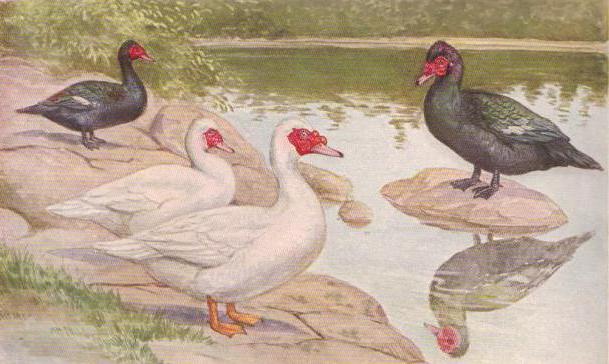
At the base of the beak and eyes, musky ducks have special growths, which are brightly pigmented warts. The plumage in birds can be blue-white, black or chocolate. In most cases, the body has stripes or spots. In general, musky ducks look, breeding at home which is very profitable, quite original. You can distinguish them from representatives of other breeds by the sounds they make. These unusual birds do not quack, like other varieties, but hiss. This duck got its name due to the fact that during the breeding season a drastic musky smell emanates from the drakes.
Advantages of the Variety
Many owners of household plots and farms refuse to support ducks at all because of their voracity and too fat, not as tasty as that of chickens, meat. The musky variety is completely lacking. Her meat is juicy, but absolutely not fat. Store this product is allowed up to one and a half years.
Pasture - that’s why mainly ducks gain weight. Breeding them at home, thus, is a low-cost procedure. The advantage of keeping the duck musk on meat is also the fact that, unlike ordinary breeds, it can do without a reservoir.
Disadvantages of the variety
Minuses such an occupation as breeding a musky duck, practically does not have. The only drawback of this variety, according to many summer residents, is its low hatchability. The hatching rate of eggs of musky duck is very low, both during natural incubation and during artificial incubation. The explanation for this is very simple. The fact is that the birds' eggs of this species are covered with a very dense, shell-like film, poorly permeable to air. Because of this feature, the respiration of embryos is strongly restrained. And consequently, their development slows down.
What should be the room
Musk ducks, breeding, rearing, the maintenance of which is a relatively simple matter, develop well, however, such a statement is true only if comfortable conditions are created for them. The house is usually built about the same as for chickens. In any case, the barn should be quite spacious. If the ducks in the house feel cramped, they can even begin to lose weight. Thus, during the construction of the shed, it must be borne in mind that at least 1 m must be occupied by 8 individuals2 area. But it’s better to make the house more spacious.
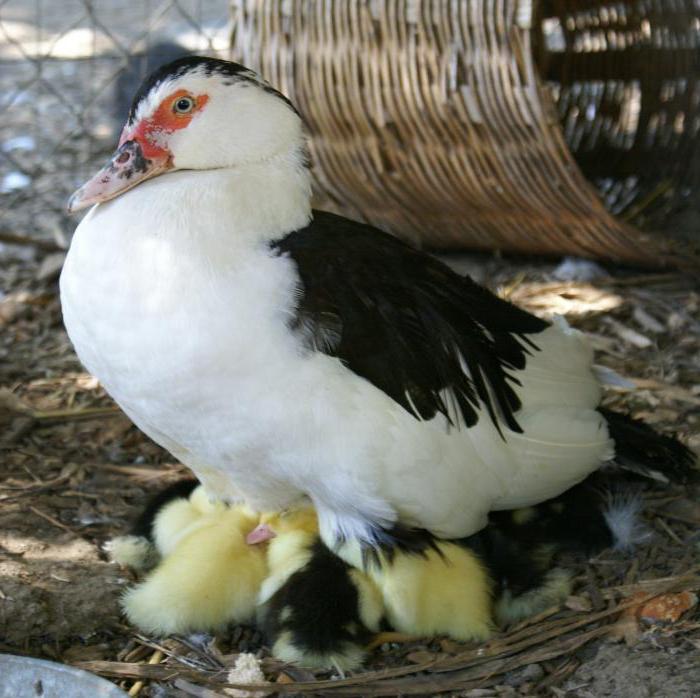
Of course, the room containing the ducks should be dry and well ventilated. To prevent the occurrence of infectious diseases, the floor of the house should be covered with a thin layer of lime-cannon. On top of it you need to lay peat or wood shavings.Also, owners of cottages containing musky ducks advise to pay more attention to its lighting during the construction of the house. In this case, breeding of musky duck (photos are presented on the page) will be more profitable. The fact is that with enough light, this bird develops much better. A window facing the south side in the barn is required in any case. And of course, several lamps should be hung in the house.
One of the features of musky ducks is that they do not tolerate low temperatures. Therefore, the barn will have to be insulated and heaters put in it. The air temperature at the floor should ideally not drop below +18 gr. Heat these ducks also do not like. Therefore, the optimal temperature bar is 20 gr. You can find out how comfortable the bird feels by its behavior. If the ducks are knocked together, it means they are cold. If they open their beaks and breathe hard, the air temperature in the house should be lowered by turning off some of the heaters or opening windows and doors.
How to equip a barn
The musky duck, breeding which requires good care, of course, needs not only a convenient house. The barn still needs to be properly equipped. One of the distinguishing features of this bird is that it can fly. Therefore, in the poultry house for such ducks, as well as for chickens, roosts are equipped. However, in this case they are not placed too high. Of course, feeders and drinking bowls should be installed. The first should be wide enough. The easiest way to use the old trough under the trough. The drinker in the barn needs to be put more. These birds drink a lot and often.
Breeding musky duck at home involves, among other things, equipping the house with nests. Every female should have a place for laying and hatching eggs. The easiest way to build nests is to use ordinary wooden crates. From their walls you need to pull out on the board, thus arranging the entrance for the duck. You can also make more convenient sockets. To assemble them from scratch, boards and timber are usually used.
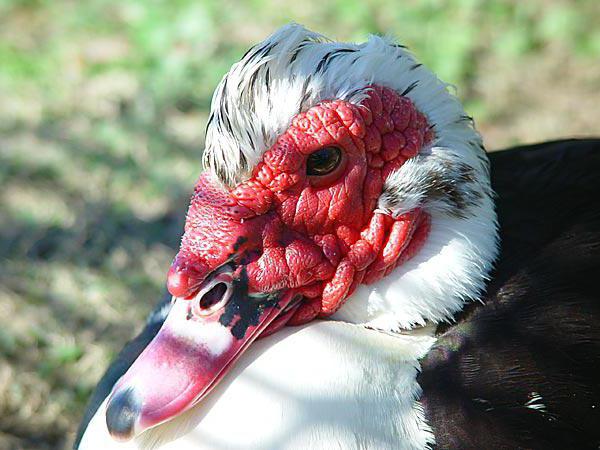
How to make an indochka nest
The most suitable material for making nests is wide boards with a thickness of at least 20 mm. Pre-assembled frame of timber 40 x 40 mm. The best option would be to knock down a rectangle measuring 500 x 400 x 200 mm. Further, it is divided by partitions into three nests and sheathed with boards from above, behind and on the sides. So that the eggs do not roll out, you need to arrange a nut. To do this, simply fill the board along the bottom edge in front of the frame. Ready nests are stuffed with grass and straw.
Install the resulting box in a dry place, away from drafts and so that subsequently it was convenient to remove the eggs and ducklings. The nest should be placed so that the birds do not see the hosts and other hens entering the barn. The fact is that musky ducks are stealthy. The hen will feel uncomfortable in the nest installed on sight. It is worth starting to equip places for hatchery in the winter. In this case, by spring, the ducks will get used to the nests and sit on their eggs without any problems.
Aviary
The cultivation of the musky duck suggests the presence of a place specially designated for walking near the barn. Aviary must be closed from above. As already mentioned, musky ducks can fly. In the aviary, as in the barn, you need to install drinking bowls and feeders. Also inside the walking "courtyard" should arrange cups with ash. The presence of a pond when breeding musky ducks is an optional condition. However, water procedures have a very good effect on the development of this bird. Therefore, it is worth equipping a small artificial pond in the aviary. You can make it, for example, from an old bath. The latter just needs to be dug into the ground. To make it easier for ducks to get out, on the edges of the bath, it is worth putting long boards with rails stuffed across (some kind of "ladders").
Such a small artificial pond is suitable for a small number of ducks. If there are a lot of birds in the country, it is better to arrange a real artificial pond. To do this, dig a large pit in the ground. Further, its walls and bottom are concreted. Water in such a pond, unfortunately, is usually quickly polluted. Therefore, it will have to be periodically pumped out and replaced with a new one.
Before releasing ducks into the aviary, you need to carefully examine its territory. There are some things you definitely need to know about gardeners who decide to go in for a business like raising musky duck. The peculiarities of keeping a bird in an aviary are that it needs to be closely monitored. The fact is that these ducks can sometimes swallow completely inedible objects. First of all, walking should be inspected for the presence of everything shiny. Indoor women like these things in particular. This applies, for example, to fragments of glass, nails, screws, etc.
In winter, poultry is released only at a sufficiently high air temperature. This species, unfortunately, has very sensitive flippers. With prolonged exposure to cold, ducks can simply freeze them.
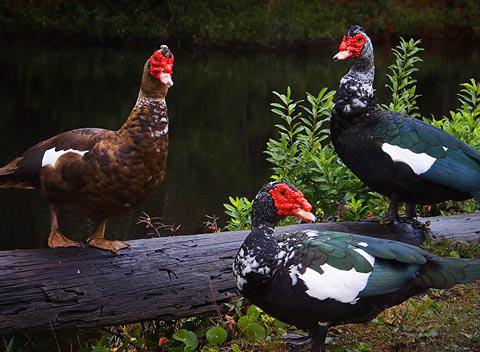
How to feed an adult bird
In the diet of ducks from the age of 20 days without fail include boiled potatoes. At night, the bird is given germinated grain. In addition, adults must be fed green mixes on skim milk or bran. Breeding musky duck in the country is no more troublesome than keeping, for example, the same chickens. But there are still some nuances in the cultivation of this bird. So, for example, in no case should ducks be given products:
- sour or moldy;
- sliced in very large pieces.
Musk ducks are swallowed very greedily. And therefore, if the pieces are too large, the bird can simply choke. It is also highly recommended not to give ducks bread. It is known to contain yeast. The latter activate fermentation processes in the bird’s stomach, which can lead to a delay in development.
A musky duck, the breeding of which is relatively inexpensive, should not be limited to food, however. A feature of waterfowl is that they quickly accumulate fat. However, musky ducks, unlike other breeds, gain weight mainly due to meat. So you should not be afraid to overfeed them. But at the same time, you do not need to put too much food in the trough at a time. Duck - a bird is extremely sloppy. Therefore, if there will be a lot of food, birds simply scatter it in the barn or aviary.
Breeding rules
Relatively quick replenishment of the livestock is what distinguishes the musky duck. Breeding in the incubator of this bird is a rather complicated task. Therefore, in most cases, the owners of cottages allow ducks to breed naturally. In addition, the instinct of incubation is very well developed in this species. Ducks are quite capable of emerging young and on their own. Good maternal qualities are indicated by at least the fact that this bird is often used as a hen to breed chicks and other species of domestic birds.
For breeding choose the best individuals - with good plumage, healthy and large. A feature of the musky duck is that it degenerates very quickly with closely related mixes. Therefore, those summer residents who want to breed this bird on their own will have to contain at least 2-3 lines. To obtain offspring, four females leave one drake.

Egg laying in ducks from the age of 8 months begins in March. It lasts 4-5 months. Next, molting begins, and then the second period of laying. Thus, ducklings of this species can be bred almost throughout the entire warm season. However, many summer residents are advised to leave the hens on the nest in the spring. After all, caring for the young in the summer is much easier than in the fall.In addition, in March-May duck eggs show the highest percentage of fertility. If in spring this indicator is about 95%, then by July-August it drops to 60%.
The duck sits in the nest after it accumulates 10-14 eggs. The long development of the embryo is a characteristic feature of such a breed as musky ducks. Breeding (how many females sit on the eggs - a question that worries many novice poultry farmers) is distinguished by its features. In most cases, incubation in birds of this species lasts about 33-35 days. At the same time, the bird is almost constantly in the nest. Therefore, she needs to put food and water next to her. Some especially zealous ducks sometimes even have to be removed from the nest and sent for a walk. It is highly discouraged to touch the eggs themselves, otherwise the duck may refuse to incubate them.
After hatching, two broods usually run under one female. In this case, the second soon lays on its eggs again. Remove ducklings from the nest as carefully as possible. Musk brooders usually behave quite aggressively, protecting the brood. A duck can pinch its owner’s hands and crush stubborn eggs. Small ducklings should not be allowed into the pond. Their fluff quickly gets wet, but there is no fat layer yet. Therefore, babies can drown or even just catch a cold. Musk ducks are allowed to swim only after the appearance of the feather.
Egg incubation
Thus, the natural breeding of musky ducks is an easy task. However, sometimes summer residents and homeowners have to breed this bird artificially for various reasons. The incubation regime in this case should be strictly observed. The first two weeks, the eggs do not air and do not spray. At the same time, they are periodically turned over to 45 g. The air temperature in the incubator is kept at 37.8 aboutC at a humidity of 32%. Then, until day 30, inclusive, the eggs are cooled twice a day, opening the incubator for half an hour. Also, spraying is done twice a day. Air temperature up to 21 days is maintained at 37.6 aboutS, up to 30 - 37.4 aboutC. Humidity all this time should be approximately 29-30%. Make coups on 45 gr. until the 30th day. Next, this procedure is stopped. Until 35 days the temperature is gradually reduced to 36.9 aboutC, and humidity is increased to 34-35%. In this case, do spraying and cool the eggs continue 2 times a day.
Musk duck breeding: chick care
The first three days the brood is fed a boiled egg. Then for another 3 weeks, the chicks are given millet porridge with chopped herbs. Ducklings should be drunk with a weak solution of potassium permanganate. From the third week of life, babies can begin to give porridge from a crushed meat (oat, barley, wheat) mixed with fresh grass. From a month old, young animals are transferred to an adult diet. Until the age of 10 days, ducklings are fed 6 times a day, up to 30 days - 5 times and then 4 times.
Sometimes these birds are grown not on mishmash, but on feed. In this case, you should buy a product marked PC-5 for broilers.
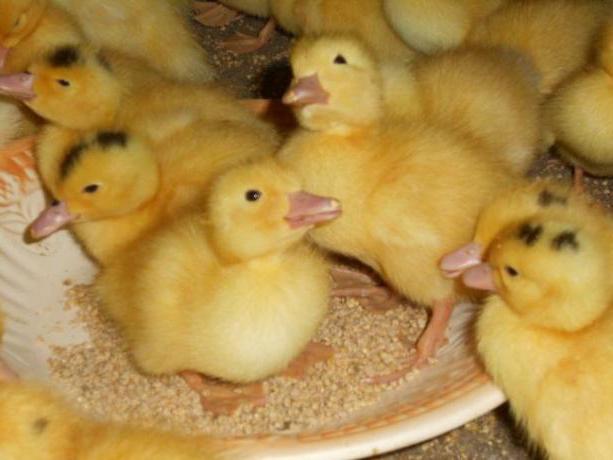
Slaughter
70-90 days after hatching is the optimum term for slaughtering such a bird as musky ducks. Breeding and keeping them for a longer time is a disadvantageous business. This is explained by the fact that after reaching the age of three months, ducks begin to eat a lot (disproportionately added weight). By the 90th day, the average female weight reaches about 2.5 kg, the drake - 5 kg.
Actually, the face itself is produced by cutting veins through an open beak with scissors. Next, the carcass is suspended for blood flow. Then it must be kept for 3-4 hours until the fat solidifies. The carcass is freed from the feather using conventional technology. That is, first, large tail and fly feathers are removed. Then clean the back, sides, tail, chest and neck. At the final stage, the wings are plucked and stumps are removed.
Methods of marketing products
Breeding musky duck is a pretty profitable home business.But, of course, profits can only be made if markets exist. The poultry of this species, as already mentioned, is distinguished by simply excellent taste. Therefore, it is in demand in the market and is quite expensive. In order to further increase revenue and avoid losses, you should:
- apply additional nutrition with vitamins;
- keep ducks clean;
- do not allow the bird to bathe in cold water (up to 18 degrees).
Well, of course, you need to follow the diet. You can sell duck carcasses, for example, in the city market. Some summer residents also take them to stores. There is another way to make money. The fact is that duck liver and heart are used to make the homeopathic medicine Oscillococcinum, which is used to treat flu.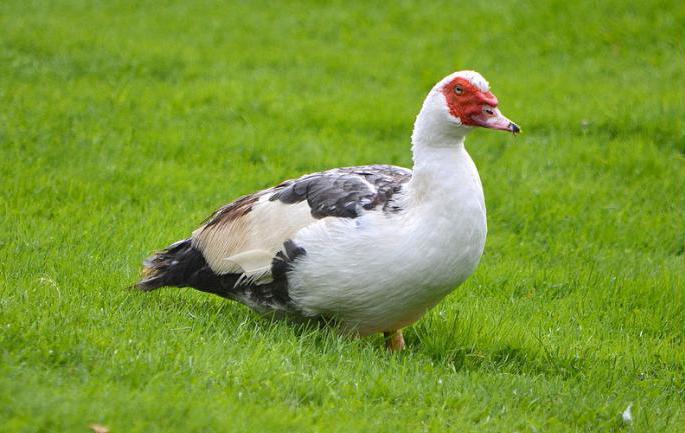
Thus, breeding musky ducks as a business can be a truly profitable business. The main thing is to observe the technology of reproduction and feeding of birds. In this case, the stock will quickly replenish, and young growth will develop well.








